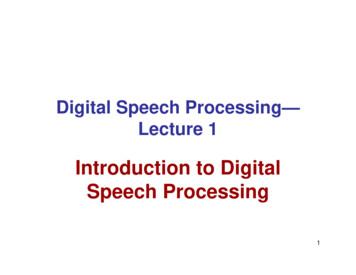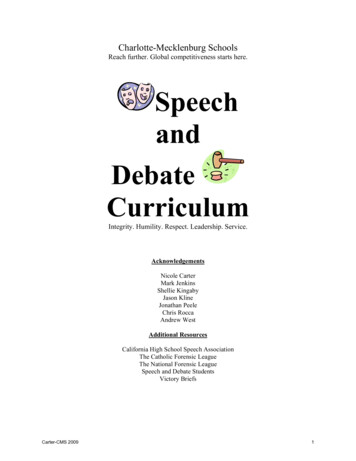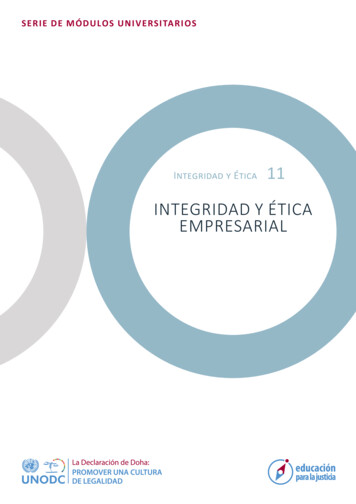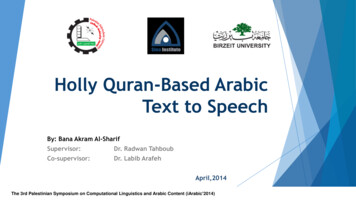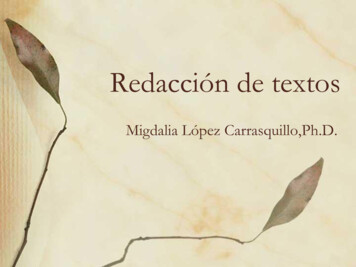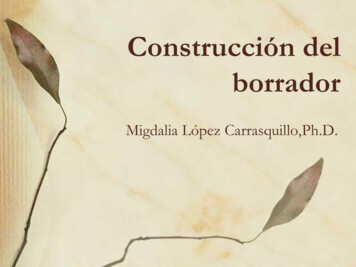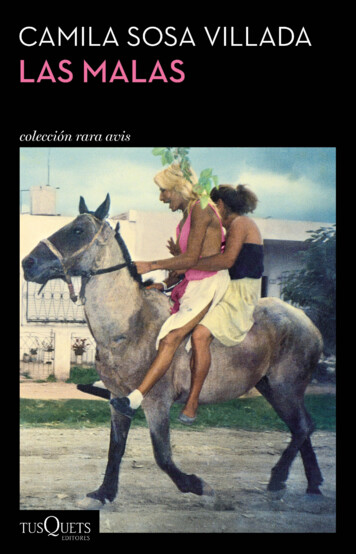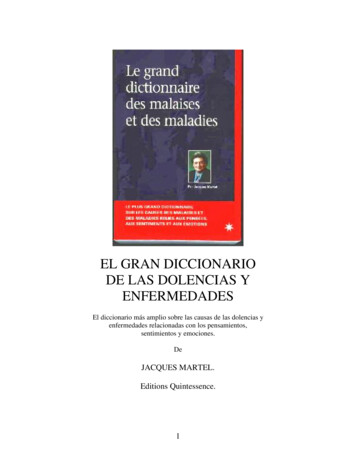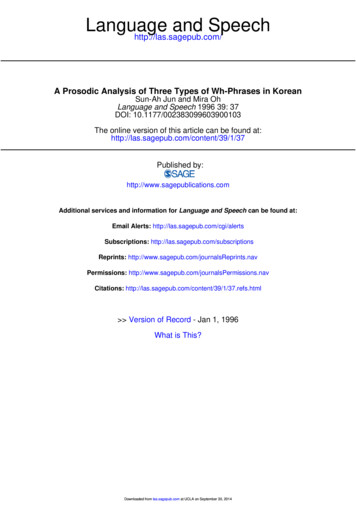
Transcription
Languageand Speechhttp://las.sagepub.com/A Prosodic Analysis of Three Types of Wh-Phrases in KoreanSun-Ah Jun and Mira OhLanguage and Speech 1996 39: 37DOI: 10.1177/002383099603900103The online version of this article can be found at:http://las.sagepub.com/content/39/1/37Published by:http://www.sagepublications.comAdditional services and information for Language and Speech can be found at:Email Alerts: http://las.sagepub.com/cgi/alertsSubscriptions: http://las.sagepub.com/subscriptionsReprints: ions: tions: http://las.sagepub.com/content/39/1/37.refs.html Version of Record - Jan 1, 1996What is This?Downloaded from las.sagepub.com at UCLA on September 30, 2014
LANGUAGE AND SPEECH, 1 9 9 6 , 39 111. 37- 6 137A Prosodic Analysis of Three Types ofWh-Phrasesin Korean ::SUN-AH JUNUiiiversity of Califorilia, Los AiigelesMlRA OHYeojoo Techriical College, KoreaKEY W O R D SABSTRACTaccentual phrasingWh-phrases in Korean are ambiguous due to the lexical ambiguity of“wh” words: wh-pronouns as in a wh-question, or indefinite pronounsincredulous questionas in a yeslno-question. Furthermore. since a wh-word in Korean is insitu (i.e. not moved to the front of a sentence as in English), wh-questionsprosodicare not distinguishcd from echo questions i n their surface forms. In thishyperarticula tionpaper, we investigated prosodic characteristics disambiguating ihesethree types of wh-phrases: 1) wh-qucstion, 2) yeslno-question, and 3)speaker strategyincredulity question, a kind of echo question giving an incredulity nieaning. Production and perception data were examined to discover whatwh-questionprosodic features are used to distinguish these three types of wh-phrasesand which feature is more salient and reliable in perceiving such differyes/no-questionences. The production results show that yeslno-questions and other typesof questions are distinguished by different accentual phrasing, whileincredulity and wh-questions are distinguished by different peak amplitudes, pitch ranges, andboundary tones. Interestingly, not all speakers used the same strategy to distinguish incredulityfrom wh-questions. The results of the perception test suggest that accentual phrasing is significantlyrelated to the perception of three types while amplitude and boundary tones are significantly relatedto the perception of wh- and incredulity questions, respectively.INTRODUCTIONAs shown in previous studies of intonational meaning (Ladd, 1980;Bolinger, 1989;Hirschberg&Ward, I992), particular prosodic features contribute to utterance interpretation. Wh-phrases*The experimental part of this work was completed while both authors werc at the Departmentof Linguistics, the Ohio State University. We thank the Department of Linguistics for theuse of laboratory facilities. We also thank hlary Beckman and two anonymous reviewers fortheir helpful comments and encouragement, and S. Takayanagi for her assistance in statistics.In addition, the second author thanks Mary Beckman for giving her the opportunity toconduct research as a visiting scholar at the Ohio State University. An earlier version of thispaper was presented at the International Conference on Spoken Language Processing in 1993.Address for correspondence: Dr. Sun-Ah Jun, Department of Linguistics, 3 125 CampbellHall, UCLA, 405 Hilgard Ave., Los Angeles, California 90095-1543, U.S.A. E-mail:jun@humnet.ucla.eduDownloaded from las.sagepub.com at UCLA on September 30, 2014
38A prosodic analysis of wh-phrasesin Korean are known to be ambiguous in three ways due either to the lexical ambiguity ofa wh-word or to the syntactic property of a wh-phrase. Thus, it is expected that these whphrases are disambiguated by one or more prosodic features.“Wh” words in Korean have two lexical functions: either as a wh-pronoun as in a whquestion, or as an indefinite pronoun as in a yeslno-question. For example, since /nuka/ hastwo possible meanings, “who” and “anyone,” the question /nuka wajo/? (wa “to come” jo “interrogative ending”) can mean “Who is coming?” or “Is there anyone coming?” Thelexical ambiguity of a wh-word has been impressionistically noted to be differentiated byprosodic features such as “pitch accent” (Chang, 1973; Choe, 1985), boundary tones (Martin,1951; Choe, 1985; Lee, 1990), or high versus low pitch (Cho, 1990). By pitch accent theseauthors mean “phonological prominence”; thus, if a wh-word is “phonologically prominentcompared to other elements of the sentence” (Choe, 1985, p. 114), that word is interpreted asa wh-pronoun. However, the phonetic realization of phonological prominence is not specified.In addition to these prosodic differences, it is also noted in Cho (1990) and Lee (1990)that the two interpretations of wh-words differ in their phrasing relative to the followingword. Cho (1990, p. 56) claims that a wh-word is intonationally focused when it functionsas a wh-pronoun, thus forming one phonological phrase together with the following word,given that the following word does not belong to a separate phonological phrase. The roleof phrasing in the perception of wh-questions and yeslno-questions has also been noted forTokyo Japanese (Maekawa, 1991) and Kumamoto Japanese (Maekawa, 1991). Using aperception test of synthetic intonation, Maekawa showed that a phrase boundary marked bya falling tone between the wh-word and the following word is perceived as a yesho-questionwhile the lack of a falling tone in the same position is perceived as a wh-question. Thus, itseems that the same segmental string of a wh-phrase can be interpreted either as a wh-questionor as a yeslno-question depending on each type’s prosodic features and phrasing differences.But, to our knowledge, no instrumental study of this phenomena has been done for Korean.In addition to the two interpretations of a wh-phrase due to the lexical ambiguity of thewh-words, a wh-question in Korean is also ambiguous with an echo question because,unlike English, the wh-word in a wh-question is not moved to the front of a sentence butstays in its underlying position, that is in situ. Thus, wh-questions are not distinguishablefrom the echo question in which the echoed word is substituted for a wh-word in the sameposition, as shown in (1).(1) /meali-kaMary-NOMhakkjo-ekas’-ajo/.school-LOC[ wh]went-ending”“Mary went to a school.”wh-question: /mealika atie kas’ajo/? (ati “where”)echo-question echoing “school”: Jmealika atie kas‘ajol?“Where did Mary go?“Mary went where?”Echo questions are generally used when the listener is not sure of what the speaker said.However, echo questions are also used when the listener knows what has been uttered butDownloaded from las.sagepub.com at UCLA on September 30, 2014
S.-A. Jun and M. Oh39is surprised to hear it. In this papcr, we will confine our investigation on the latter type ofecho question and call it the “incredulity question” (Oh & Lee, 1993). Thus, the incredulityquestion /nuka wajo/? means “WHO did you say is coming? ( I can’t believe that X iscoming. (and the speaker knows who X is.)).” We added this type of question because itdiffers from other types of question in that it implies surprise while the others d o not. It hasbeen found in other languages that incredulity is expressed by employing higher amplitudeand a bigger pitch range. For example, in English, it has been claimed that an i/icrediilirjreading in English is associated with shorter duration, greater amplitude, and a larger pitchrange in production compared to an irncermhfyreading, but only a large pitch range has beenfound to be perceptually salient in the perception of iricredirliq (Hirschberg & Ward, 1992).In this paper, we will examine phonetic characteristics of prosodic features and phrasingto investigate how these three types of questions, the wh-question, yesho-question, andincredulity question, are distinguished from each other. Then we will examine whichprosodic feature is perceptually more salient in distinguishing three types of questions:based on utterances produced by speakers in the production experiment. For the phoneticdescription of phrasing and prosodic features of Korean, we will adopt the model of Koreanprosody developed by Jun (1993). In this model, she proposed two prosodic units higher thana phonological word based on the intonation pattern of an utterance: an Accentual Phrase andan Intonational Phrase. An Accentual Phrase can have more than one phonological word andis marked by a phrase-final rising tone in Seoul Korean (the tonal details differ in otherdialects). An Intonational Phrase can have more than one Accentual Phrase and is markedby a boundary tone and a phrase-final lengthening followed by an optional pause. Being ata higher.prosodic level than a phonological word, the Accentual Phrase is at the same levelas the phonological phrase of Korean proposed by Cho (1990). Kang (1992), or Silvn (1989),adopting the Prosodic Hierarchy Theory developed by Selkirk (1986) and Nespor and Vogel(1986). But theAccentua1 Phrase differs from the phonological phrase since its formation isbased on the intonational pattern of an utterancerather than on the syntactic structure of asentence. To emphasize the tonal basis of the phrase, Jun called the phrasal unit an AccentualPhrase. Since this prosodic model is based on the tonal-temporal properties of an utterance,we can compare the pitch range and the timing of peaks and valleys as well as the tonalpattern and phrasing of the three types of wh-phrases.A brief description of the tonal pattern of an Accentual Phrase and the tone-syllableassociation is in order. The tonal pattern of the Accentual Phrase in the Standard (Seoul)dialect has two alternate forms: one is Low-High-Low-High and the other is High-HighLow-High. This pattern is determined by the laryngeal feature of the phrase initial segment.If the segment is either an aspirated or tense obstruent, the phrase has a HHLH pattern,otherwise the phrase has a LHLH pattern (Jun, 1996). The first tone (Low or High) isrealized on the first syllable of the phrase, the following High tone on the second syllable ofthe phrase, the following Low tone on the penultimate syllable of the phrase, and the finalHigh on the final syllable of the phrase. (But, since all examples used in this experiment havea LHLH pattern, no HHLH pattern is shown in this paper.) When an Accentual Phrase is thelast Accentual Phrase in an Intonational Phrase, this phrase final H tone is overridden by anIntonational Phrase boundary tone. That is, if an Intonational Phrase boundary tone is Low,the final syllable of the last Accentual Phrase would not be realized as its underlying Hightone, but is pre-empted by the Low boundary tone of the Intonational Phrase. A schematicrepresentation of the realizations of the basic tonal pattern of an Accentual Phrase in SeoulDownloaded from las.sagepub.com at UCLA on September 30, 2014
40A prosodic analysis of wh-phrasesa) 1-3 syllables0 0 GL (HL) Hb) 4 syllablesG O 0 0LHLHc) 5 syllables0 0L H'.*0 0L HFIGURE 1A schematic representation of tonal realizations of the basic tone pattern of an AccentualPhrase in Seoul dialect of Korean. The surface tonal pattern of (a) less than four syllables, (b)four syllables, and (c) more than four syllables of an Accentual Phrase.dialect is shown in Figure 1. The middle High tone is realized on the second syllable of aphrase if the phrase has more than four syllables. Thus, the realization of the middle Hightone depends on the number of syllables in the phrase. When the phrase is shorter than foursyllables, it is not realized due to undershoot. The peak of the middle High tone is in generallower than that of the final High tone. See Jun (1993) for a morc detailed description of theAccentual Phrase.Thus, the tonal pattern of a wh-phrase would be different depending on the accentualphrasing of its constituent words. If awh-word forms one Accentual Phrase by itself, we willfind a High tone at the end of the wh-word and a Low tone at the beginning of the followingword, but if a wh-word forms one Accentual Phrase together with the following word, thesecond syllable of the wh-word will have a High tone (because the phrase will be of morethan four syllables) and the following Low tone will be realized on the penultimate syllableof the phrase. We can then determine whether there is an Accentual Phrase boundary byexamining the timing of peaks and valleys relative to the syllables in ;Iwh-phrase. In addition,we can measure FO values and amplitude at several points in a wh-phrase to compare threetypes of questions. The production data will be discussed in Experiment 1 and the perceptiondata will be discussed in Experiment 2.EXPERIMENT I: PRODUCTIONMethodStrbjecis. Four Seoul speakers in their early thirties participated in the experiment: twofemale (speaker Y and speaker 0)and two male (speaker Land speaker C). Speakers Y, L,and C were graduate students at the Ohio State University, Columbus, Ohio. Speakers Yand C have been in the United States about four years, and speaker L for three years.Speakers Y, L, and C reported that they speak Korean at home and to other Koreans in thedepartment, amounting to 50% of daily life. Speaker 0 (the second author) has visited theUnited States periodically in the last six years. Her durations of stay ranged from 2 to 24months.Downloaded from las.sagepub.com at UCLA on September 30, 2014
S.-A.Jun and M. Oh41TABLE akol“what” or “anythin c”Yvho” or “anyone”“when” or “any time”“where” or “any place”“with whom” or “with anyone”“with whom” or “nith anyone”Moterial. Twenty sentence types were designed so that each could be interpreted inthree ways: wh-question, incredulity question, and yesho-question. Each sentence had awh-word followed by a verb (henceforth,.wh-phrase) and the wh-word was precededeither by an adverbial phrase, /onil tJanjak-e/ “today night-in ( tonight),” o r by a nounphrase, /atJumani-ka/nin/lil/ “madam-case marker ( madam-h.O l/TOP/ACC),”depending on the meaning of the wh-phrase. This adverbial or noun phrase (henceforth, pre-whphrase) was added before the wh-phrase to see if there is a pitch range difference outsidethe wh-phrase depending on the question type. Every sentence ended in a question particle /-jol (except for one sentence which ended with /-a/) so that any difference in theboundary tone would not be due to the inherent meaning of the particles, but to the question type. Six wh-words were used in this experiment and they are shown in Table 1. Toinvestigate possible changes in the tonal patterns of the wh-word arid the following verbdue to their accentual phrasing, we varied the number of syllables in the wh-words (fromone to four syllables) as well as the number of syllables in the following verbs (from oneto five syllables). However, due to difficulty of measurement, only two to five syllableverbs were analyzed. The list of all sentences appears in the Appendix.Each type of question was triggered by a corresponding dialogue either as an answeror as a statement. Wh-questions and yesho-questions were triggered by the type of answer:if the answer started with “Yes” or “No,” the wh-phrase should be interpreted as a yeshoquestion, but if the answer started with a name of a person, place, thing, or a time, the phraseshould be interpreted as a wh-question. For incredulity questions, we tried to provide a statement describing an unexpected fact before the wh-phrase to evoke the incredulity readingmore naturally. In addition lo this contextual cue, an explicit phrase describing incredulity,/nollatisi, mitil su aptanintisil (“Being surprised, and as if one cannot believe this”), waswritten in parenthesis next to the target wh-phrase. (2) and (3) below show two representative sentences with corresponding dialogues. In each dialogue, the subject’s part, A part in(a) and (b) and B part in (c),was highlighted with a fluorescent pen and the ivh-word withthe incredulity meaning was marked by a dot underneath each syllable of the word in orderto draw the subject’s attention. Here, “/.I”represents a phonemic representation.(2) /onil tlanjake mw3 makajol ?(a) for wh-question meaning:A: lonil tJanjake miva makajo/? (“What are we eating tonight?”)B: /tJ’atJarjpap makajo/. (“We are eating tJ‘atJaq-rice.”)Downloaded from las.sagepub.com at UCLA on September 30, 2014
42A prosodic analysis of wh-phrases(b) for yesho-question meaning:A: /onil tJanjake mwa makajo/? (“Are we eating anything tonight?”)B: /kilamjo, kapjaivunkalato makajatJjo/. (“Yes, we should eatsomething light.”)(c) for incredulity question meaning:A: /oniltJanjake ivansugi koljoli makilkajejo/.(“We will eat monkey’s brain tonight.”)B: /onil tJanjake miva makajo/? (/nollatisi, mitil su aptanintisi/)(“WHAT are we eating tonight?” - Being surprised, and as if onecannot believe this.)(3) /atJurnaninin antJe atfilaivajol ?(a) for wh-question:A: /atJumaninin antJe atfilawajo/? (“Madam, when do you feeldizzy?”)B: /siksatJane atfilawajo/. (“I feel dizzy before meals.”)(b) for yesho-question:A: /a tJuman in in an tJe a tfilawajo/?(“Madam, is there any time that you feel dizzy?”)B: jje, kanhok antJassta ilananijan atfilaivajo/.(“Yes, some of the times when I stand up from sitting.”)(c) for incredulity question:A: /nan hansum p’hk tjakonamjan atfilawajo/.(“I feel dizzy when I sleep well.”)B: /atJumaninin antJe atfilawajo/? (/nollantisi, mitil suaptanintisi/) (“Madam, WHEN do you feel dizzy?” - Beingsurprised, and as if one cannot believe this.)Procedure. A short dialogue (a question and answer pair) for each type of wh-questionwas written on a card (5.5 inch x 8.5 inch). A total of sixty (3 types x 20 sentences)dialogues were pseudo-randomized so that the same type of question did not appear threetimes in a row. For each dialogue, the second author read the answer or the statementcorresponding to the question. The sixty dialogues were repeated three times by eachspeaker. The recording was made in a soundproof booth. The subjects’ utterances weredigitized and analyzed using Entropic Research Laboratory’s XWAVES speech analysissoftware. The peak RMS amplitude was measured at two points in the utterance: the whword and the question particle at the end of an utterance. In addition, FO values and time(referenced to the beginning of the utterance) were measured on the pitch track for sevenpoints: two points from the pre-wh-phrase, and five points from the wh-phrase includingthe utterance final point. A sample pitch track with seven measurement points alignedDownloaded from las.sagepub.com at UCLA on September 30, 2014
S.-A. Jun and M. Oh43FIGURE 2A sample screen of XWAVES program showing a spectrogram, a waveform, a FO contour,and a label window marked by seven measurement points: the lowest FO of the pre-whphrase (A), the highest FO of the pre-wh-phrase (B), the lowest FO after B (C), the peak FO ofthe wh-phrase (D), the lowest FO after D (E), the beginning of the question particle (F), andthe utterance final FO (G) with information of a boundary tone: 1 refers to a High boundarytone. Sentence: /atfumanika antJe mantilajol [adsumaniga and3e mandirajo] “madamNOhl. when to make-int.” “When does madam make (it)?’’ (Speaker L).with a spectrogram and a waveform is shown in Figure 2. The two points measured in thepre-wh-phrase were: the lowest FO (A) and the highest FO (B). A was always the beginning of the pre-wh-phrase, that is utterance initial, and B was the end of the pre-whphrase. The five points in the wh-phrase were: the lowest FO after B (C),the highest FO ofthe wh-phrase (D), the beginning of low after D (E), the beginning of the question particle(F), and the utterance final FO (G). The point F was located at the highest second formantDownloaded from las.sagepub.com at UCLA on September 30, 2014
A prosodic analysis of wh-phrases44u]of (or the beginning of [a] for one sentence type) in the spectrogram. After G , information on the type of a boundary tone was added. l after G in Fig. 2 indicates a High boundary tone (H%).Seoul Korean has been analyzed as having at least six boundary tones: L%, H%, LH%,HL%, LHL%, and HLH% (Jun, 1993). Each boundary type was determined depending onthe FO shape of the utterance final syllable. Thus, if the syllable /jo/ or /a/ began with a lowtone and rose to a higher FO in the middle of the syllable, we labeled it LH%. The syllablewas labeled H% if its onset showed no sign of a low plateau but rathera rising FO.’ The samecriterion was used for the distinction between LHL% and HL%. Sample contours of fourboundary tone types uttered in this experiment, H%, LH%, HL%, and HLH%, are shown inFigure 3.Results and DiscussionThe three question types, wh-question, yestno-question, and incredulity question, were distinguished by the combination of boundary tones, accentual phrasing, and pitch ranges andpeak amplitude.The inventory of boundary tones and the percentage of each boundarytone used in each question type is shown in Figure 4 on page 46. There was no single boundary tone type specific to one type of wh-question. Yesho-questions and incredulity questions were most often realized with High boundary tones (H%), although they sometimesappeared with LH boundary tones (LH%) for all four speakers. The most common boundary tone for wh-questions was LH%, although H% and HL% were also observed, and onespeaker (Speaker C) used all four boundary tones with roughly comparable frequencies.In addition to these different types of boundary tone, there was also a difference in thephonetic realization of the high boundary tone. Within a given category of boundary tone,a high tone was in general significantly higher in incredulity questions than the high tone inyesho-questions, which was itself higher than the high tone in wh-questions. Table 2 showsthe mean FO values and the results of ANOVA and Tukey post-hoc tests for each questiontype (at .01 level). HL% and HLH% were not compared because these types occurred onlyin wh-questions. All speakers showed significantly different FO values for the LH% tonebetween question types: Incredulity Yestno-questions Wh-questions. The same relationBoiiiihr tones.’ It was found that the same wh-question type employs H% as well as LH%, providing asimilar meaning. But, in other type of sentences, we found that the pragmatic meaning of asentence or phrase changed depending on which type of boundary tone was used. Thus, itwas not always true that every phrase ending with H% can be replaced with LH% withoutchanging the pragmatic meaning. For example, in the following sentence, LH% is usedmeaning “confirmation,” “seeking listener’s agreement” or “speaker’s insistence andconfidence,” but if we use H%, the sentence has only the literal meaning. “if.”ex. 1. /X-lil thoghesa jejakilhetfusimjan, (LH%) tJeka p’alli tJ%lihalsuis’ajo (L%)/“X-ACC. through make ;Ireservation. (LH%) I-NOM. quickly handle-can-ending” “(1 am sure) I can handle it quickly if you make B reservation through X.”Downloaded from las.sagepub.com at UCLA on September 30, 2014
S.-A. Jun and M. Oh45FIGURE 3Example FO tracks of wh-question sentences showing four different boundary tones: (a) H%(/onil tJanjake mwa makajo/ "\Vhat do (you) eat tonight?"), (b) LH% (/onil tJapjake nukiilar)mannajo/ "Who do (you) meet tonight?'), (c) HL% (/onil tJanjake nuka w j o / "Who iscoming tonight?"), and (d) HLH% (/onil 1Janjake nrika niakajol "Who is eating tonight?").All uttered by Speaker C. The first vertical line marks the boundary between a pre-wh-phraseand a wh-phrase, and the second vertical line marks the beginning of the question particle, /jo/.Downloaded from las.sagepub.com at UCLA on September 30, 2014
A prosodic analysis of wh-phrases460H%Speaker Y100 1801LH%HL%SDeaker 03-1 HLH% 6022 4020n"loo80 2whY m oInc.1,602 40.,,:.:',.20n"InC.Speaker CSpeaker L11\Y m owh.y.".,.,.:.qi:whYes/NoInC.WhYe-01 ,Inc.FIGURE 4Types of boundary tones and their percentage of occurrence for each type of wh-question.was found with the mean FO value of the H% tone except for speakers Y and 0.For these twospeakers, the H% tone was not significantly different between incredulity and yestnoquestions though the tendency was the same as in LH% tone: incredulity yesho-question.Thus, even within the same type of boundary tone, speakers in general distinguishedthree question types quantitatively. The difference in boundary tones is therefore moreprominent between wh-questions and incredulity questions than between incredulity questions and yesho-questions or between wh-questions and yestno-questions.AccerifrralpliI-asirig. Accentual phrasing was categorically different between the yestnoquestions and the other two types of questions.Al1 speakers produced the wh-phrase as twoDownloaded from las.sagepub.com at UCLA on September 30, 2014
S.-A.Jun and M. Oh47TABLE 2Mean FO values (Hz) of the boundary tones and differences between Question-types (alleffects at p .01)-Q-typesEffectsHY0LC47551632 I257439465261196355414nodata167(2, 97)(2, 110)(1.94)(2,79)20.4110.6269.4394.65Inc. i Y/N WhInc. I Y/N WhInc. Y/NInc. YIN (2.42)(2, SO)(2, 24)50.2042.33170.288 1.83Inc. Y/N WhInc. Y/N \VhInc. Y/N WhInc. Y/N Whseparate Accentual Phrases (i.e. wh-word and the following verb each forms one Accentual Phrase) in yesho-questions, but as one Accentual Phrase in wh- and incredulity questions. This difference in accentual phrasing of a wh-phrase means that there is a different syllable-tone association. Since an Accentual Phrase in the Seoul dialect starts with alow tone and ends with a high tone, if the wh-word itself forms one Accentual Phrase, theword would end with a high FO and the following lowest FO point would be the beginningof the following Accentual Phrase (i.e. the beginning of the following verb in this experiment, regardless of the number of syllables in each word). On the other hand, if the whword and the following verb together form one Accentual Phrase as in wh- and incredulityquestions, the whole wh-phrase will be realized with the LHLH tone patterns with themiddle H tone around the second syllable of the phrase (i.e. the second syllable of a whword) and the following L tone around the penultimate syllable of the phrase (For the onesyllable wh-word, /mwa/, the middle H tone was realized on that syllable by lengtheningthe syllable). This would mean that the tone of a wh-word-final syllable and the followingverb-initial syllable would vary depending on the number of syllables in the whole whphrase because their surface tone is determined by means of an interpolation between themiddle H tone and the penultimate L tone of the wh-phrase.A schematic representation of the FO contours of two question types, yeslno-questionsversus wh- and incredulity questions, are shown in Figure 5. The example sentence given inFigure 5 is /atJumaninin antJe atJlaivajo/? (atJumani-nin “madam-Top,” antJe “any time/when,” atfilarva-jo “dizzy-honorific ending”), meaning (a) “Is there any time that you feeldizzy, madam?” versus. (b) “When (or WHEN) do you feel dizzy, madam?.” In Fig. 5 , eachAccentual Phrase is marked by a vertical line. A yesho-question, shown in (a), has threeAccentual Phrases (the pre-wh-phrase, the wh-word functioning as an indefinite pronoun,and the verb) and a wh-question or incredulity question, shown in (b), has two AccentualPhrases (the pre-wh-phrase and the wh-phrase). Thus, the distance between the peak of wh-Downloaded from las.sagepub.com at UCLA on September 30, 2014
A prosodic analysis of wh-phrasesBD0 ( J ( T ( T O0 0 (T O 0c5L H L H L Ha tJu ma ni ninan tJe a tJi la wa j o ?LHL H“anytime”BD/0 0 0 0 0L HL Ha tJu ma ni ninan tJe a tJi la wa j o ?“when”FIGURE 5A schematic representation of FO contours of wh-phrases of (a) yesho-question versus (b)wh-question and incredulity question in Seoul Korean. A vertical line marks the boundary ofan Accentual Phrase. (a) shows three Accentual Phrases: the pre-wh-phrase. the wh-word andthe verb, and (b) shows two Accentual Phrases: the pre-wh-phrase and the wh-phrase. Ahorizontal arrow represents the distance between D and E.phrase (D) and the beginning of the lowest FO after the peak (E) would be longer when bothD and E belong to the same Accentual Phrase as in (b) than when both points belong todifferent Accentual Phrases as in (a). Table 3 shows the mean time difference in ms betweenD and E in three types of questions for four speakers. One factor ANOVA test shows thatthere is a main effect of question types for all speakers, F(2,641) 500.347, p c .0001. ADownloaded from las.sagepub.com at UCLA on September 30, 2014
49S.-A. Jun and M. OhTABLE 3The mean time difference (ms) between D (peak FO of the wh-phrase) and E (the lowest FOafter the peak) of three wh-question(Q) types for four speakers. (One standard error in theparenthesis.) In each cell 50 I I I I 6 0-Q- YP Y0LC425.08 (16.0)4 19.92 ( 18.2)390.04 (15.4)365.53 (16.4)364.59 (1 5.4)413.28 (18.2)341.93 (18.0)406.23 (20.0)12 1.43 (4.4)118.01 (5.6)93.43 (2.7)106.48 (2.9)Tukey post-hoc analysis shows that the time difference (D - E) in yesho-questions is significantly shorter (at the .01 level) than those in the other two types for all speak ers.In addition, we expect that, for yesho-questions, the mean time difference between Dand E will be stable regardless of the number of syllables in the verb, while, for wh- andincredulity questions, the mean time difference of DE will increase as the number of syllables in the verb increases. Since the number of syllables in the verb differed from two tofive syllables in our data. we ran a two factor ANOVA (question types and the number ofsyllables in a verb (V-syll)) on DE duration. The result showed that there is a main eff
38 A prosodic analysis of wh-phrases in Korean are known to be ambiguous in three ways due either to the lexical ambiguity of a wh-word or to the syntactic property of a wh-phrase.Thus, it is expected that these wh- phrases
